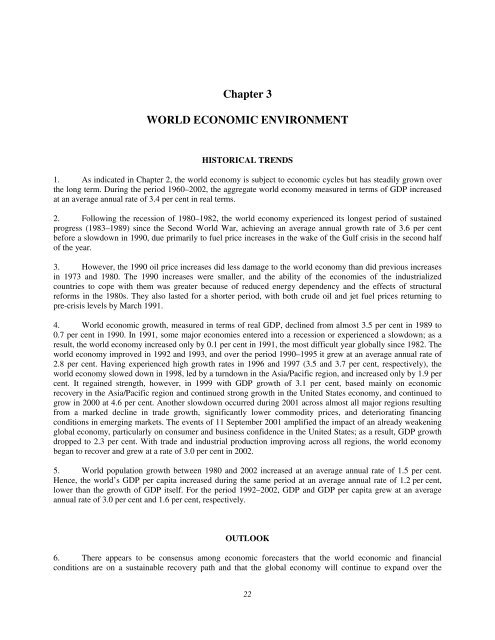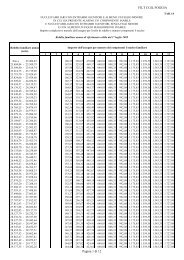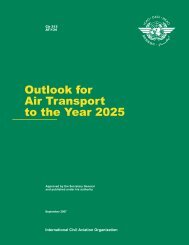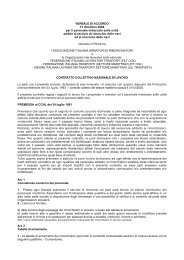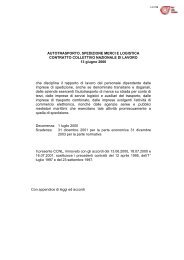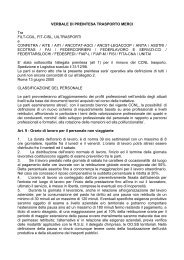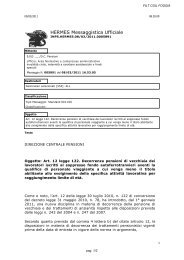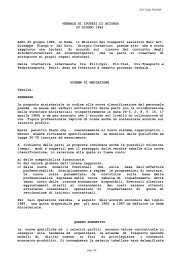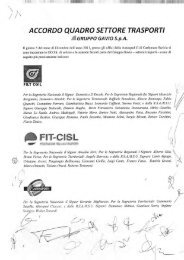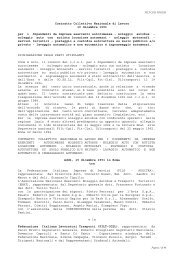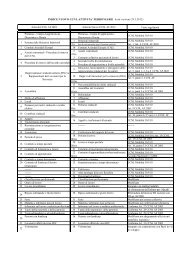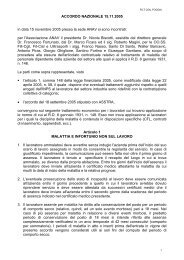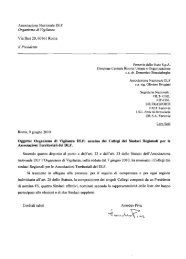Outlook for Air Transport to the Year 2015 - FILT CGIL Foggia
Outlook for Air Transport to the Year 2015 - FILT CGIL Foggia
Outlook for Air Transport to the Year 2015 - FILT CGIL Foggia
You also want an ePaper? Increase the reach of your titles
YUMPU automatically turns print PDFs into web optimized ePapers that Google loves.
Chapter 3WORLD ECONOMIC ENVIRONMENTHISTORICAL TRENDS1. As indicated in Chapter 2, <strong>the</strong> world economy is subject <strong>to</strong> economic cycles but has steadily grown over<strong>the</strong> long term. During <strong>the</strong> period 1960–2002, <strong>the</strong> aggregate world economy measured in terms of GDP increasedat an average annual rate of 3.4 per cent in real terms.2. Following <strong>the</strong> recession of 1980–1982, <strong>the</strong> world economy experienced its longest period of sustainedprogress (1983–1989) since <strong>the</strong> Second World War, achieving an average annual growth rate of 3.6 per centbe<strong>for</strong>e a slowdown in 1990, due primarily <strong>to</strong> fuel price increases in <strong>the</strong> wake of <strong>the</strong> Gulf crisis in <strong>the</strong> second halfof <strong>the</strong> year.3. However, <strong>the</strong> 1990 oil price increases did less damage <strong>to</strong> <strong>the</strong> world economy than did previous increasesin 1973 and 1980. The 1990 increases were smaller, and <strong>the</strong> ability of <strong>the</strong> economies of <strong>the</strong> industrializedcountries <strong>to</strong> cope with <strong>the</strong>m was greater because of reduced energy dependency and <strong>the</strong> effects of structuralre<strong>for</strong>ms in <strong>the</strong> 1980s. They also lasted <strong>for</strong> a shorter period, with both crude oil and jet fuel prices returning <strong>to</strong>pre-crisis levels by March 1991.4. World economic growth, measured in terms of real GDP, declined from almost 3.5 per cent in 1989 <strong>to</strong>0.7 per cent in 1990. In 1991, some major economies entered in<strong>to</strong> a recession or experienced a slowdown; as aresult, <strong>the</strong> world economy increased only by 0.1 per cent in 1991, <strong>the</strong> most difficult year globally since 1982. Theworld economy improved in 1992 and 1993, and over <strong>the</strong> period 1990–1995 it grew at an average annual rate of2.8 per cent. Having experienced high growth rates in 1996 and 1997 (3.5 and 3.7 per cent, respectively), <strong>the</strong>world economy slowed down in 1998, led by a turndown in <strong>the</strong> Asia/Pacific region, and increased only by 1.9 percent. It regained strength, however, in 1999 with GDP growth of 3.1 per cent, based mainly on economicrecovery in <strong>the</strong> Asia/Pacific region and continued strong growth in <strong>the</strong> United States economy, and continued <strong>to</strong>grow in 2000 at 4.6 per cent. Ano<strong>the</strong>r slowdown occurred during 2001 across almost all major regions resultingfrom a marked decline in trade growth, significantly lower commodity prices, and deteriorating financingconditions in emerging markets. The events of 11 September 2001 amplified <strong>the</strong> impact of an already weakeningglobal economy, particularly on consumer and business confidence in <strong>the</strong> United States; as a result, GDP growthdropped <strong>to</strong> 2.3 per cent. With trade and industrial production improving across all regions, <strong>the</strong> world economybegan <strong>to</strong> recover and grew at a rate of 3.0 per cent in 2002.5. World population growth between 1980 and 2002 increased at an average annual rate of 1.5 per cent.Hence, <strong>the</strong> world’s GDP per capita increased during <strong>the</strong> same period at an average annual rate of 1.2 per cent,lower than <strong>the</strong> growth of GDP itself. For <strong>the</strong> period 1992–2002, GDP and GDP per capita grew at an averageannual rate of 3.0 per cent and 1.6 per cent, respectively.OUTLOOK6. There appears <strong>to</strong> be consensus among economic <strong>for</strong>ecasters that <strong>the</strong> world economic and financialconditions are on a sustainable recovery path and that <strong>the</strong> global economy will continue <strong>to</strong> expand over <strong>the</strong>22


